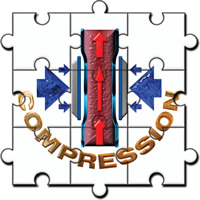The 2013 HME Handbook: Compression
Active Therapy for Active Lifestyles
How to market compression products to baby boomers.
 The Baby Boom generation comprises approximately 76 million people and has already started entering the age in which they need the products and services HME providers offer. But these aren’t the traditional retirees that HME providers have come to know.
The Baby Boom generation comprises approximately 76 million people and has already started entering the age in which they need the products and services HME providers offer. But these aren’t the traditional retirees that HME providers have come to know.
Consider boomers the generation that refuses to age gracefully. Instead, baby boomers are angling to live life to the fullest for as long as they can. They want to go bike riding, they want to go dancing, they want to travel, and they aren’t going to let anyone tell them they can’t.
But what baby boomers will do is seek out the products that can help them lead those active lifestyles. Those products could be a new pair of sneakers, they could be a new pair of sunglasses, or those products could be compression garments. In other words, as far as baby boomers are concerned, compression garments are just like any other product.
The key in successfully marketing compression products to baby boomers lies in the approach and the messaging. If anything, successfully offering compression products to baby boomers is a matter of perspective. Is a pair of compression hosiery an item for “senior citizens,” or is it instead an athletic product, or a healthy living product?
Once providers understand the perspective for approaching their marketing to baby boom clients, they can begin to start developing the messaging that will resonate with boomers. Like any patient group, the goal is to provide a complete package of products, services and marketing appeals that will ensure baby boomers see a provider as a resource for helping them get the most out of life.
Let’s look at some key considerations in developing and implementing marketing campaigns that will drive baby boomers to seek out and use compression products:
Boomers aren’t patients. Often providers will refer to their clients as patients, but that is the last word providers want to use when referring to this group. The same goes for “seniors” or “retirees.” Instead, refer to baby boomers as “people with active lifestyles” who might need “additional support.” Appeal to their sense of wanting to do more, and offer a solution to help them accomplish that (i.e., compression garments).
Similarly, the imagery you use in your marketing pieces should reflect this messaging approach. When you’re sending newsletters, emails, or brochures, depict Baby Boom-aged people engaged in vigorous activities. Check with your vendors to see if they offer marketing support materials in this vein.
Recognize the standard appeals, as well. In addition to the benefits compression can offer in leading active lifestyles, baby boomers are suffering ailments typical to their age: arthritis, venous insufficiency, post-surgical and medical treatment side effects, lymphedema and diabetes, to name a few. Obviously, the provider needs to address these in its marketing efforts as well, but crafty compression products will play down the age element when marketing boomers with these message points. Simply acknowledge the medical condition, and not the fact that it might come with age.
Accentuate the fashion element. Gone are the days of simple, fleshtone and white garments that scream “support hose.” Baby boomers want compression garments that look good enough that they don’t want to hide them. Fortunately, compression garment vendors are responding by offering some very appealing and stylish designs in various colors. Moreover, their marketing materials are also playing up this angle, as well, showing active, attractive people proudly wearing the latest offerings as though they just stepped out of the pages of Vogue magazine.
Focus on product advances. Baby boomers are attracted to leading-edge offerings, so in addition to the fashion element, focus on the advances made with today’s compression garments in terms of not just look, but feel and capability. Discuss how in addition to looking good, these items are easier to put on and take off than the compression garments of the past, while still offering therapeutic support. These are message points that will resonate with the baby boomer audience.
Get involved with this key constituency. Don’t expect to simply develop a list and send out marketing materials. Providers must interact with baby boomers, as they are a customer group that is research intensive. They want to fully understand a product and feel that they are making an informed purchase. Savvy providers will undertake active efforts to attract and interact with boomers via social media to foster that dialog. Also, consider getting involved with community events that will attract baby boomers either by hosting an information booth, or speaking about the benefits of compression products.
The bottom line? Baby boomers might be retiring, but they’re not settling down — not by a hot minute. So as long as a provider’s approach to compression products jibes with that point of view, it will find success.
Points to take away:
- Baby boomers might be getting older, but they are still leading active lifestyles. Compression products can help them do that.
- The key to attracting boomers to compression products lies in developing marketing methods that play up those active lifestyles.
- Other marketing materials should tactfully address medical issues common to baby boomers that compression addresses.
- Today’s compression products reflect boomers’ desire for solutions that are fashionable and don’t look “medical.” Ensuring marketing efforts reflect that.
- Baby boomers are research-intensive buyers who like to self-education before buying. Interact with them via social media and events.
Learn More:
This article originally appeared in the June 2013 issue of HME Business.